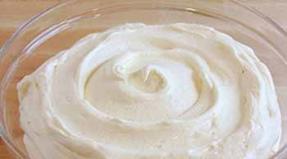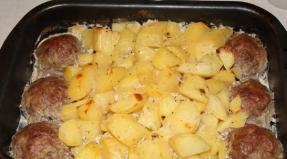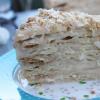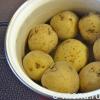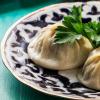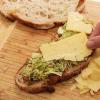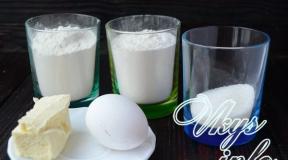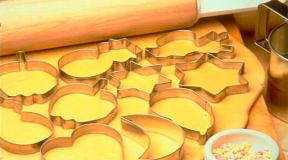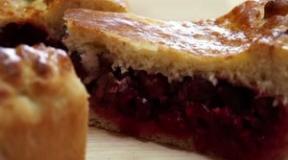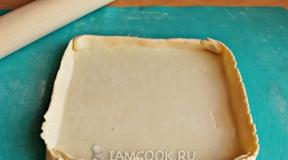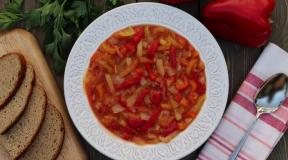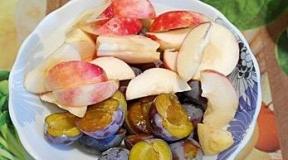The magical properties of fruits and berries. Magic fruit - a plant that alters taste sensations
Magic fruit or miracle fruit (Synsepalum dulcificum) - evergreen shrub or small tree of the Sapotov family.
An evergreen shrub reaches a height of 1.5 meters, oblong dark green leaves are located on thin branches, which grow in a spiral. Flowering continues almost all year round, the flowers are small, no more than 7 millimeters, creamy white.
Fruit of the magic fruit bright red, small, 2-3 cm long, oblong drupe, which in appearance resembles a barberry berry. The fruit is not sweet, tastes good. Most of the fruit is occupied by 1 large bone. At home, the plant bears fruit almost all year round. In their native habitat, 2 large crops are harvested, each after the rainy season. The fruits ripen 3 to 4 weeks after flowering. They must be eaten immediately after collection; during storage, they lose their properties.
The fruit contains a glycoprotein (miraculin protein), which has the unique property of influencing the taste buds in such a way that the sour taste is replaced by a sweet one, and all aroma properties and taste sensations are fully preserved. The lemon eaten after this fruit appears sweet, while the citrus flavor and aroma are fully preserved. The effect lasts from half an hour to two hours. When dried, the unique properties are lost, so it is recommended to freeze the fruits immediately after harvest for further storage.
Miracle fruit It can be used as a natural sweetener, it is recommended for people on a diet and experiencing an irresistible craving for sweets. The fruits can be frozen for later use.
The fruits of the magic fruit also have other beneficial properties. The fruits of this plant contain many trace elements that are necessary to maintain the normal functioning of the human body. Also, the magic fruit is rich in plant acids and fiber, which restores the work of the stomach and intestines.
West Africa is considered the birthplace of this plant.
The use of a magic fruit. Locals in tropical West Africa, where staple foods such as cereals and soups are traditionally sour, use the berry extensively, both to add sweetness to foods and palm wine and to muffle stale food.
Useful properties of a magic fruit. By eliminating the need for sugar, the miracle fruit can provide health benefits for diabetics and weight loss people looking to make healthy, low-calorie foods more appealing. Research in Taiwan has shown that consuming magical fruits can improve insulin sensitivity among diabetics. In addition, the berry is used as a therapy for cancer patients undergoing chemotherapy. Such patients often experience a metallic taste in their mouths, which makes their food unpleasant to the taste, preliminary research has shown that eating the magic fruit can mask this taste, thereby encouraging food intake and improved appetite.
Magic fruit- a plant of the Sapotov family. West Africa is considered the birthplace of these fruits.
The fruit is a small drupe, colored fuchsia, similar to a barberry and reaches a length of about 3 cm. Inside the fruit there is a white seed, which is no larger than a coffee bean in size (see photo).
Beneficial features
A feature of this fruit is the ability to act on the taste buds and for some time "turn off" those that are responsible for the perception of sour taste, that is, if you eat a lemon after the magic fruit, it will seem sweet. This is due to the protein content of miraculin. The effect lasts for 2 hours.
In addition, the composition of the magic fruit includes vitamins and microelements, which have a positive effect on the activity of the whole organism. There is fiber in the fruit, which improves bowel function and helps prevent or treat constipation.
Cooking use
The magic fruit is used for food in the countries where it grows. Since in Africa all dishes are sour, the fruits are put to give them a sweet taste.
Magic fruit benefits and treatment
 The benefits of the magic fruit have been evaluated through experiments. For example, recent studies have shown that eating fruits helps increase the body's sensitivity to the action of insulin, which is very important for people with diabetes. In addition, berries are used as an additional therapy for cancer patients undergoing chemotherapy. Thanks to the magic fruit, you can get rid of the metallic taste in your mouth.
The benefits of the magic fruit have been evaluated through experiments. For example, recent studies have shown that eating fruits helps increase the body's sensitivity to the action of insulin, which is very important for people with diabetes. In addition, berries are used as an additional therapy for cancer patients undergoing chemotherapy. Thanks to the magic fruit, you can get rid of the metallic taste in your mouth.
The harm of the magic fruit and contraindications
Magic fruit can harm people with individual intolerance to the product.
In the photo, the magic fruit looks like a completely ordinary shrub several meters high. In appearance, it can even be confused with barberry. But don't trust the first impression. The real magic is revealed only when you taste its fruits.
What is this fruit?
The magic fruit, or Synsepalum dulcificum, is also called the miraculous berry and sweetish path. It belongs to the Sapotov family, which includes many exotic and unusual species, such as the star apple, Shea tree, Turkish delight, spadodilla.
The Synsepalum dulcificum plant is an evergreen shrub with dense leaves and neat white flowers. Its bright red oblong berries outwardly resemble dogwood or barberry, and their taste is weak and has a slight sweetish tinge.
The "magical" ability of the fruits of the pathia is that they change perception for a short time, and sour food after them seems sweet. Lime, lemon, sorrel, green apples and other foods become completely different for a short time and allow you to enjoy other nuances of their taste. The effect lasts from half an hour to an hour, but in such a short time, you can taste a lot of everything. The main thing is not to get too carried away and not to eat something that can harm the body, because even vinegar with magic berries will acquire a quite tolerable taste.
The secret of the journey
He got the amazing properties of the magic fruit thanks to the presence of the glycoprotein miraculin in his cells. Once in the mouth, it binds to receptors that are responsible for the sensation of sweetness, regulating their action. Interestingly, in a neutral environment, it suppresses them, so foods even with a high sugar content seem less saturated than they really are. In an acidic environment, miraculin has the opposite effect and strengthens sweet receptors, drowning out the sour taste.

Where does the wonderful berry grow?
The magic fruit comes from West Africa, where for a long time it was known exclusively to the locals. The Europeans learned about the miracle fruits thanks to the French cartographer Chevalier de Marcheise. In 1725, he explored the African continent and came across an amazing delicacy that the aborigines used when eating acidic foods. Most often, pouria berries were used to sweeten palm wine, a popular alcoholic drink that is obtained by fermenting coconut juice.
Today, the wonderful fruit is also grown outside of Africa. The plantations and small gardens where it is cultivated can be found mainly in North America (Puerto Rico, Florida) and in parts of Asia, such as Thailand and Japan.

Application
The magic fruit did not gain insane popularity in the world, but its amazing properties did not go unnoticed by the pharmaceutical and food industries. In a number of countries, its berries are used as a dietary supplement and a sweetener for unpleasant-tasting medicines. They are recommended for diabetics or people with high blood sugar, as well as those who want to lose weight, but are unable to overcome the obsessive desire for sweets. Helps the fruit and cancer patients. It does not relieve cancer and other serious diseases, but it can block the metallic taste in the mouth, which often appears in people after chemotherapy and radiation therapy.
In addition to the well-known effect, pouria has other advantages. Like many other fruits, it contains vitamins and minerals, amino acids, and intestinal fiber. You can make various cocktails, pies, desserts from it and use it as an ordinary product. The effect of miraculin will be manifested only in fresh fruits, the shelf life of which is only two to three days. When dried or heat treated berries, the protein is destroyed and loses all its effect.
Own miracle tree
The magic fruit is a tropical plant accustomed to living in hot and humid conditions. But, with some effort, it can be grown in your own apartment. In nature, the shrub prefers medium acid soils with a pH level of 4.5 - 5.8. It does not tolerate frost and extreme cold, but can withstand periods of drought and shade.

Under natural conditions, the plant can reach 3 to 6 meters in height, but in the house it usually reaches no more than 1.5 meters. Travel requires frequent watering, but does not tolerate stagnant moisture. The soil in her pot should be loose, breathable and well-drained. Dry air can lead to yellowing or disease, so it needs to be sprayed at least once a day.
It grows in the form of a beautiful oval or pyramidal bush with many leaves, which are densely located at the edges of the shoots. But the path is in no hurry to grow, it manages to reach 50-60 centimeters in about five years. She begins to bear fruit much faster than many exotic plants. Three years after planting, you can see the first magical fruits. To preserve all of their excellent properties, it is best to place them in the freezer right away. So, they will delight you throughout the year.
How much is a magic fruit (average price for 1 kg.)?
Moscow and Moscow region
The magic fruit rightfully deserves its name due to a special property that can be called unique. The fact is that it is capable of completely changing the perception of taste. However, we will talk about this later, and consider this fruit from the point of view of gastronomy.
The plant, which is an evergreen shrub or a small tree, belongs to the sapote family. It comes from West Africa. About a month after the end of flowering, shiny bright red berries, which are distinguished by an elliptical shape, begin to appear on the shrub. We can say that they are very reminiscent of the more familiar barberry for us, the length of which hardly exceeds three centimeters.
It is noteworthy that the magic fruit is a rather whimsical fruit for storage in relation to its interesting properties. The whole problem is that it is recommended to use it almost immediately after collection, since over time all its magical qualities are lost.
And they consist in the following: if, when eating sour food (for example, lemons), you eat a berry of a magic fruit, this sourness is miraculously transformed into an extraordinary sweetness. Plus, by replacing lemon with something really sweet, that same berry tricks the taste buds into making the dish bitter. The duration of this effect directly depends on the amount of berries used, but on average, one fruit lasts for about an hour. This is such a wonderful property inherent in a magic fruit.
An unusual plant has long haunted numerous scientists, and as a result of their research on the magic fruit, they were crowned with success - the phenomenon of this berry was unraveled. So, Keiko Abe, together with his colleagues from the University of Tokyo, created cultures of special cells, thanks to which it became possible to test taste buds at different levels of alkalinity and acidity.
It turned out that a special substance called miraculin, which is found in the fruits of the magic fruit, can bind to the receptors responsible for the sweet taste. However, unlike the action of aspartame or sugars, these receptors are not able to be activated at neutral pH. The reaction begins only under the condition of an acidic environment - that is, when a product with a sour taste enters the mouth. Thus, when eating a magic fruit together with sour food, a person has the feeling that he has tasted something unusually sweet.
Therefore, scientists believe that the miraculin contained in the magic fruit has every chance of becoming one of the ideal sweeteners of natural origin for people suffering from obesity, as well as diabetics. However, in some countries, notably the United States, this natural supplement is believed to be addictive.
Calorie content of magic fruit 30 kcal
Energy value of a magic fruit (The ratio of proteins, fats, carbohydrates - bju).
Sweetish travel, sinsepalum, wonderful berries - there are many names for this unusual fruit. All of them are correct, as they are translations of plant names from different languages.
But here it is better known as "magic fruit" (from the English name Miracle fruit). It is an evergreen tree-like plant native to West Africa. There is also a variety of synsepalum that grows in the southeast of North America (Florida). It is distinguished by its large fruits.
Someone attributes this plant to shrubs, but still, outwardly, it looks more like a tree. Moreover, in some cases it grows up to 5 meters in height. The average height is 1.5-2 meters.
The "magic fruit" blooms almost all year round. The fruit is an oblong berry of bright red color, very similar to barberry. There is a bone inside the fruit.
For good development and growth, the plant needs moist and warm air. Good conditions allow the tree to bear fruit 2 times a year.
Given its thermophilicity, in our latitudes it is grown only indoors. At the same time, he feels quite comfortable. It does not require any special conditions for its maintenance, the main thing is that the soil is loose and sufficiently moist. It also needs to be periodically sprayed with moisture.
Useful properties of the magic fruit
A distinctive feature of the magic fruit is that it is not stored. Therefore, it is not subjected to any additional processing (drying, etc.), but immediately after collection it is eaten. At the same time, the berry is practically not used as an independent food product. Mostly only as a supplement. Before use, you need to make sure that the fruit is not damaged and is already mature enough. This will be evidenced by a bright red peel.But the main reason for its "magical" name is a different feature or even uniqueness. The fruit has an amazing property of "blocking" human taste buds for quite a long time (up to 2 hours). Interestingly, the synsepalum fruit itself does not have any pronounced taste. Rather, you can even note the lack of taste. But the special composition allows you to get a "sweet taste" after eating any other food product. For example, if you taste the magic fruit before drinking the lemon, the lemon will turn out to be ... sweet. The aroma and taste of citrus will be in place, but at the same time it will be sweet.
So for indoor plant lovers, there is a great way to play a trick on their relatives and friends who do not know about this special berry.
Scientists explain this property by the presence of special polyphenols in the pulp of the magic fruit. On their basis, a special substance is extracted from the berry - miraculin, which is used as a natural substitute for sugar.
That is why, and also due to its low calorie content, the magic fruit is popular for weight loss diets and the prevention of diabetes.
In addition to the above substances, the "magic berry" contains many different trace elements and vitamins: vitamin C, protein, iron, calcium and many others. Rich in fruit and fiber.
The use improves the functioning of the organs of the gastrointestinal tract, helps in getting rid of constipation.
The magic fruit has also been proven to lower cholesterol levels.
The fruits of synsepalum are also used in chemotherapy for cancer patients as an additional therapy.
